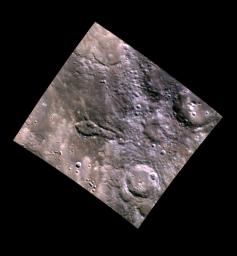This WAC color image shows an "arrow head" shaped crater. The elongated shape indicates that the feature was formed by a low-angle impact or impacts. It may represent a group of secondary craters produced by a large primary crater to the east. But what is the arrow pointing to?
This image was acquired as part of MDIS's 8-color base map. The 8-color base map is composed of WAC images taken through eight different narrow-band color filters and covers more than 99% of Mercury's surface with an average resolution of 1 kilometer/pixel. The highest-quality color images are obtained for Mercury's surface when both the spacecraft and the Sun are overhead, so these images typically are taken with viewing conditions of low incidence and emission angles.
Date acquired: March 30, 2011
Image Mission Elapsed Time (MET): 209982156, 209982138, 209982158
Image ID: 69270, 69269, 69271
Instrument: Wide Angle Camera (WAC) of the Mercury Dual Imaging System (MDIS)
WAC filters: 9, 7, 6 (996, 748, 433 nanometers) in red, green, and blue
Center Latitude: 46.31°
Center Longitude: 21.80° E
Resolution: 244 meters/pixel
Scale: The arrow head shape is about 63 km (40 miles) long.
Incidence Angle: 52.4°
Emission Angle: 0.5°
Phase Angle: 53.0°
This image was acquired as part of MDIS's high-resolution 3-color imaging campaign. The 3-color campaign is a major mapping activity in MESSENGER's extended mission. It complements the 8-color base map (at an average resolution of 1 km/pixel) acquired during MESSENGER's primary mission by imaging Mercury's surface in a subset of the color filters at the highest resolution possible. The three narrow-band color filters are centered at wavelengths of 430 nm, 750 nm, and 1000 nm, and image resolutions generally range from 100 to 400 meters/pixel in the northern hemisphere.
The MESSENGER spacecraft is the first ever to orbit the planet Mercury, and the spacecraft's seven scientific instruments and radio science investigation are unraveling the history and evolution of the Solar System's innermost planet. Visit the Why Mercury? section of this website to learn more about the key science questions that the MESSENGER mission is addressing. During the one-year primary mission, MDIS acquired 88,746 images and extensive other data sets. MESSENGER is now in a year-long extended mission, during which plans call for the acquisition of more than 80,000 additional images to support MESSENGER's science goals.
These images are from MESSENGER, a NASA Discovery mission to conduct the first orbital study of the innermost planet, Mercury. For information regarding the use of images, see the MESSENGER image use policy.

 Planetary Data System
Planetary Data System












